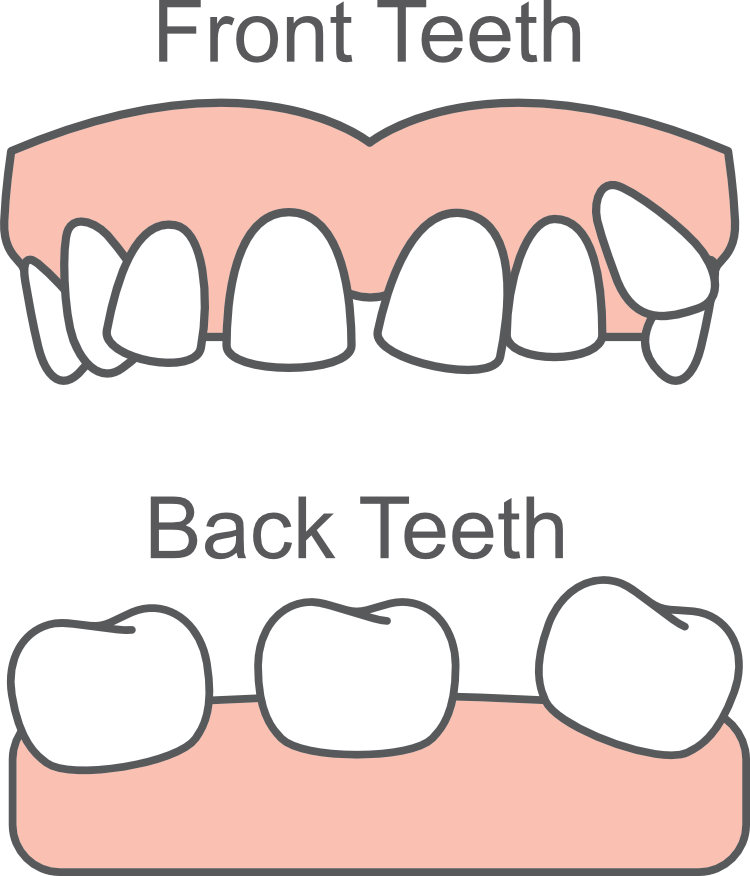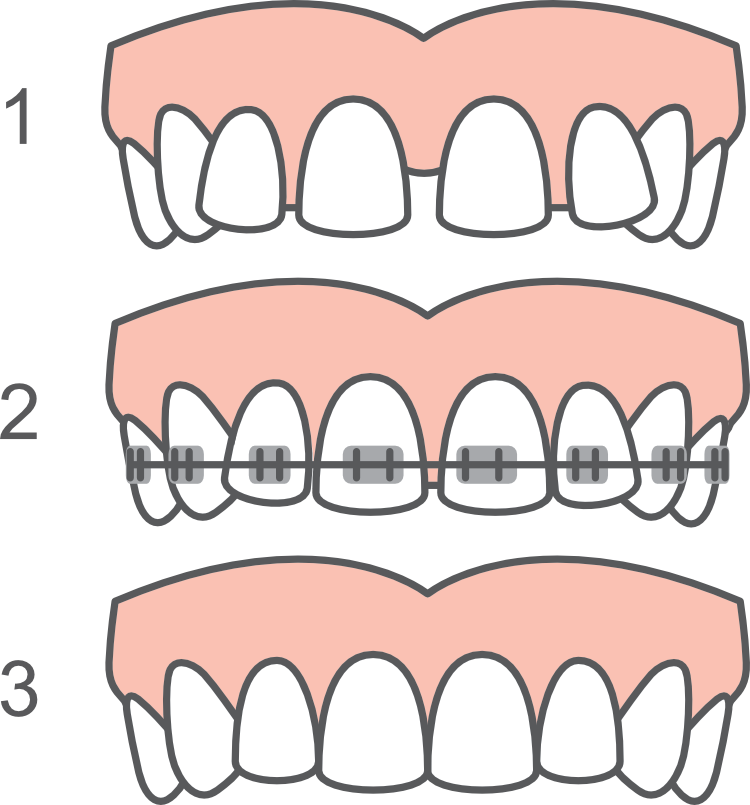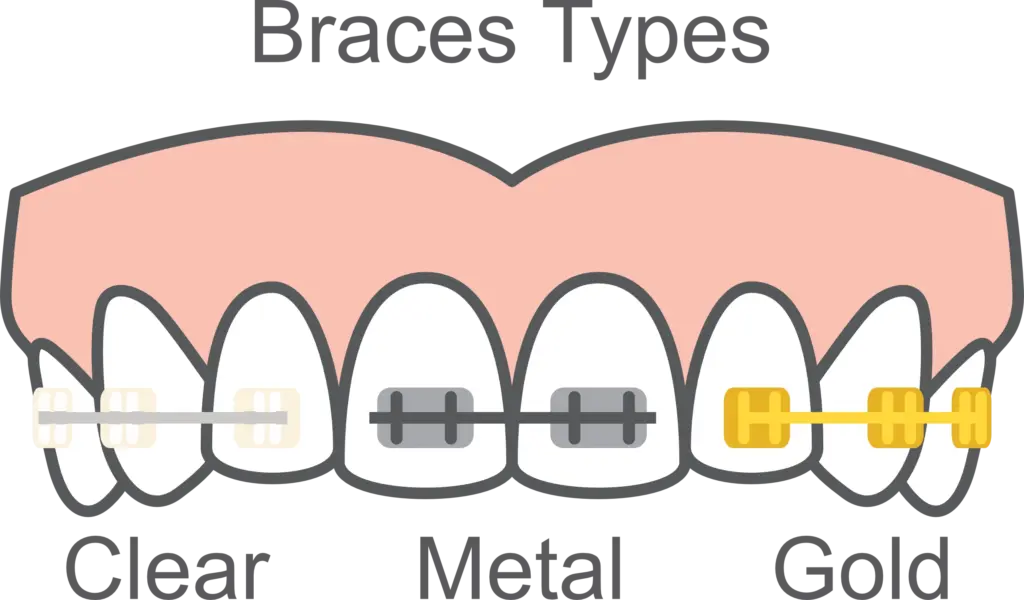Braces for Gap Teeth: All You Need to Know!
Braces for gap teeth are an effective treatment. Have you ever seen someone smile and noticed a space between their teeth?
That’s called a “gap.” Some people love their gap, while others wish to close it. Let’s explore more about this!

What is a gap in teeth?
A “gap in teeth,” often known as a “diastema,” is a space that appears between two of your teeth.
Just like how we all have unique fingerprints, our smiles can be unforgettable, too.
A gap is just one feature that makes some smiles special, but some smiles are not so special, and closing this gap can have the same effect.

How do people feel about having gap teeth?
Feelings about gap teeth vary. For people with multiple gaps, like the image above, it is not a good feeling.
However, some famous stars like Madonna love their gap tooth.
Others, like Michael Strahan, proudly rock the gap in front teeth and make it their signature.
It’s like a signature style for them. But only some feel the same.
Some people might feel a bit shy about their gap, especially if others point it out a lot.
You see, those celebrities have a “perfect gap.” Meaning the space is uniform, looks good aesthetically, and does not negatively affect them healthwise. Most people don’t have a “perfect gap” and they want it fixed!
At Augusta Orthodontics, Dr. Herny Dallam has talked to many people, some of whom love their gaps and some who wish to close them with braces for gap teeth.
What causes teeth gaps?

Growing up is the most common cause of gapped teeth. Teeth move and shift around as your skeleton and teeth develop.
- Teeth grow in with a gap. Perfectly natural and fixed braces for gap teeth.
- Baby teeth are lost too soon. Permanent adult teeth grow in with a space.
- A single tooth is too small. This little tooth does not reach the teeth next to it.
- The jaw is too big. There’s so much room. The teeth just spread out.
- An incoming tooth pushes the other out of the way.
Bracket braces can fix gaps and spaces in teeth, whatever the cause and wherever the location.
Where is the most common location for teeth gaps?
The most common place to see a gap is between the two upper front teeth. It’s right in the center, so it’s often the first thing people notice when they smile.

The front teeth are the most common place for spaces to happen because these teeth have more room to grow in than the back teeth.
The back (posterior) teeth have less space to grow in properly, so gaps are less common.
However, gaps between teeth can develop and should be fixed using braces for gap teeth.
Keeping the front gap in teeth is okay, but leaving a gap in the middle or back teeth can lead to health issues.
What are the health risks of not fixing gaps?
While a gap isn’t always a problem, sometimes it can cause issues. These problems are especially true for the back teeth.
Gaps can trap food, leading to gum problems, tooth decay, or cavities. Regularly flossing and brushing isn’t enough to prevent damage from trapped food in a teeth gap.
Teeth need to be tightly aligned together to prevent this.
Also, if the gap is because of missing teeth or a tooth and jaw size mismatch, it could cause bite problems.

A bad bite might lead to troubles like chewing food, biting lips and tongue, and even jaw pain.
Braces for gap teeth can correct this and it will help reduce or eliminate the pain.
When these issues are present, people should contact an orthodontist.
How do orthodontists fix gaps in teeth?
Orthodontists are like smile superheroes!
They use braces and/or Invisalign to shift teeth and close gaps.
Dr. Dallam uses gentle methods to slowly and permanently fix teeth with spaces in between them.
Braces put mild pressure on the teeth. Over time, this pressure moves the teeth closer together, fixing the gap.
- Step 1: Free Consultation & Braces On
- Step 2: Brace Gently Close Gap
- Step 3: Braces Off & Gaps Gone

Occasionally, Dr. Dallam will use springs, rubber bands, or other modern orthodontic devices to close the gap.
Dr. Hank at Augusta Orthodontics has helped many residents in the Augusta area with braces for gap teeth and get the smile they dream of using.
Does fixing gap teeth require dental prosthetics?
Occasionally, dental prosthetics must be used when orthodontics alone can not fix the gap. Large spaces, more than 6 MM wide, or when a missing tooth is the cause.
Augusta Orthodontics has a team of dental partners that can provide the necessary filling for oversized gaps.
Whether you need a referral or can have Dr. Dallam fix your teeth spacing, most patients want to know how long it will take to correct diastema (spaced) teeth.
Do you need dental bonding?
Dental bonding may be necessary for some patients—usually ones with smaller teeth.
Traditional braces for gap teeth can’t always close the space with these smaller teeth.
Bonding is a cost-effective solution for addressing gaps between teeth.

The procedure primarily involves the application of a tooth-colored resin material to the teeth.
The resin, carefully matched to your natural tooth color, is applied, shaped, and smoothed to cover the gap.
Properly aligned teeth make bonding a lot more successful in the long run.
Once the teeth are straightened, it creates a seamless appearance between the teeth.
Dentists will hit the bonding material with a UV light, and it is good to go.
Once complete, this technique enhances your cosmetic appearance by eliminating unsightly gaps and protecting the tooth by providing a sealed, uniform surface.
Bonding works fantastic, but we avoid using it because we prefer your braces fix the gaps in teeth.
How long do braces take to fix the gap in teeth?

The time it takes to fix a gap depends on the size of the gap and the treatment chosen.
With braces, it might take anywhere from 6 months to 2 years. During this time, gaps are often slowly closed before the treatment is complete.
But every person is different, so the best way to know is to schedule a free consultation with our experienced orthodontist, Dr. Dallam.
What type of braces fix gap teeth?
Traditional metal braces are the best method to fix gaps in teeth. Augusta Orthodontics team uses braces to gently and precisely close the gaps.
- Ceramic (Clear) Braces
- Metal (Silver) Braces
- Gold (Stylish) Braces

They use bracketed braces for most patients with mild to severe gaps because of their strength and versatility.
Traditional braces for gap teeth come in various types, including conventional metal braces, gold braces, and ceramic clear braces.
Dr. Dallam may also consider using clear aligners to correct gaps.
Can Invisalign fix gaps in teeth?

Invisalign can be used to fix minor or narrow gaps.
Invisalign is a series of clear, invisible appliances that patients wear over time to fix the voids between teeth.
Initially, the Augusta orthodontics team will scan your teeth and work directly with Invisalign to plan your treatment.
After your scans, they will carefully place the anchors that move your teeth. The appliances will attach to these anchors to close the spaces.
Clear aligners may not close medium to large gaps between teeth or overly crowded teeth. Braces for gap teeth are needed for these patients.
However, every patient is different, and a free consultation with Dr. Dallam is your best bet.
How do patients feel after getting the gap fixed with braces?
Most patients feel fantastic!

While some miss their unique gap, many are super excited about their new smile.
Additionally, they know their teeth and gums will be healthier in the long run.
More and more studies point to better overall health due to healthy teeth.
They feel more confident and can’t stop showing off their teeth and new smiles.
So, whether you love your gap or wish to close it, remember that every smile is unique and beautiful. If you ever think about changing yours,
Augusta Orthodontics and Dr. Herny Dallam are always there to help!
Article inspired by information from Augusta Orthodontics and insights from Dr. Herny Dallam.